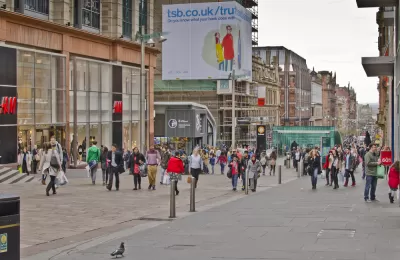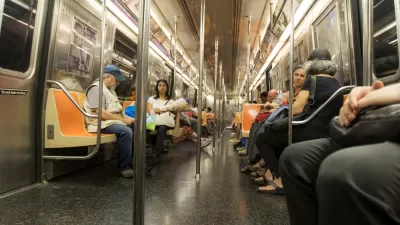Take a walk around your downtown and what do you see. Most people are attached to their mobile phones, using them for directions, searching, and texting. See how can cities leverage digital technology to create a more engaging city center.

I am in Glasgow, Scotland with students and faculty from around the world learning about Cities and Citizens in the Digital Age. The sessions have been wonderful, and I am sharing in installments a number of the key sessions that would be of interest to the Planetizen community.
Alex Maxwell, a postdoctoral fellow at the University of Strathcylde in the Urban Design Studies Unit, is exploring how digital technologies will influence consumer behavior and shape the city center experience in the next five years.
Glasgow has a bold aim to be a world-leading digital city. The Glasgow Chamber of Commerce and Urban Land Institute came together to create Think Digital Scotland, which is an effort to imagine the future of a city center, using a technology o create a "vibrant, digitally integrated and successful city centre." The white paper shares thoughts on key technologies, the importance of city centers and the potential for the future. To launch the report and highlight how technology is changing our cities, the chamber of commerce literally delivered the white paper via a drone.
_Buchannan_Street,_Glasgow.jpg)
Glasgow's Buchanan Street is an important pedestrian street in the city center and also a place with free wifi.
Why all the fuss over city centers? City centers are some of the most complex and influential places, with high levels of density, diverse ownership patterns, and a variety of places where people want to live. The success of city center investments in Glasgow depend on joint partnerships with the public and private sector, given limitations on public funding.
Glasgow city center has 150,000 jobs, the largest student population in Scotland, and 2.2 million visitors per year. It's also the United Kingdom's second most popular retail destination. This is a budding smart city, selected as the U.K's smart city demonstrator, Future City Glasgow to bring technology to the city.
Experience, surprise, scale, look and feel—these are key for city centers. The internet is about convenience shopping, but people are looking for experiential shopping. The city center is perfect for that.
Connectivity is key to creating an interactive experience in city centers. Glasgow became the first city in Scotland to offer free wifi in the city center. The Urban Wireless program access to the wireless network in the city comes through the lease of the city’s street furniture and property, such as street lights. The city provides a license to allow a network operator to build the wireless network. The network is designed, built, and operated by a provider. The city's buses also offer free wifi and there are plans to extend wireless into other areas of the city. The free wifi improves people's experiences while visiting the Glasgow city center—providing information to tourist and event information and local businesses and services.
CCTV cameras are being used to track the flow of people and traffic. This helps city centers become more efficient with a more tailored police response. Live dashboards provide the city with information on criminal activity or a traffic accident.
The city hopes to be able to add smart parking. They would like to be able to communicate with people about where parking is conveniently located. They are thinking about incentives for people to leave their parking spots early during peak demand. This is a short-term solution with retailers being strong promoters of the strategy.
Glasgow recognizes workplaces are changing to, people need less office space. By 2020, there are expected to be five generations in the workforce in Glasgow, with young generations focused on chatting online, while older generations prefer to communicate by email. To address the diverse digital workforces, workspaces need to change. Glasgow is busy talking about co-offices—a place with good internet connectivity, good coffee and places for interaction with others.

People Make Glasgow is a key marketing campaign – promoting the friendliness of residents and the welcoming environment in the city.
"You still cannot drink your coffee online… the experience is still in retail, but the convenience is now online," says Anne Ledgerwood, General Manager St. Enoch Centre. People are researching services online before visiting a location. Retailers are learning to navigate the online and physical world. How often do you use Yelp or another online tool to research a menu at a restaurant or find out about sales at a store?
Okay great we have free wifi downtown, but how do you create more engaging digital experiences? Near field communication offers potential. Near field communication allows communication between smartphones. This allows users to gain more information through their phone. For example, the ability to send you a notification that there is free face paining in the park you are walking by.
Retailers are also jumping into digital technologies, creating a stronger, more memorable experience for shoppers. Virtual mannequins allow customers to see their chosen garment on a mannequin. The retailer Tesco is experimenting with scan as you go technology, allowing the consumer to keep a running total of your grocery bill as you shop and speed your checkout time.
Macy's is using iBeacons—when a shopper enters the store the Shopkick app alerts shoppers about deals and items they may be interested in. At Burberry's London store they are using RFID technology that when you pickup an item it triggers catwalk footage of some products when taken into the fitting room.
Beyond Glasgow
Other cities are thinking about how to digitally engage citizens in the downtown. For example, in Madrid a plaza was activated at night by providing the opportunity for people to play a game with their mobile phones and a giant screen—the result CityFireflies.
New York City provides free wifi in many public parks, subway stations and outdoor spaces, see the city’s wifi map. Boston similarly provides free wifi in popular tourist locations such as Faneuil Hall and Hyde Park. San Francisco provides free wifi in public spaces such as parks and museums. Smaller cities such as Powell, Ohio and Newton, North Carolina are providing free wifi in their downtown. And Arcata, California is an example of a small city providing free wifi on their transit system.
What is your city doing to promote a digital city center? Share your experiences and ideas for how to make an engaging digital city experience.

Planetizen Federal Action Tracker
A weekly monitor of how Trump’s orders and actions are impacting planners and planning in America.

Chicago’s Ghost Rails
Just beneath the surface of the modern city lie the remnants of its expansive early 20th-century streetcar system.

San Antonio and Austin are Fusing Into one Massive Megaregion
The region spanning the two central Texas cities is growing fast, posing challenges for local infrastructure and water supplies.

Since Zion's Shuttles Went Electric “The Smog is Gone”
Visitors to Zion National Park can enjoy the canyon via the nation’s first fully electric park shuttle system.

Trump Distributing DOT Safety Funds at 1/10 Rate of Biden
Funds for Safe Streets and other transportation safety and equity programs are being held up by administrative reviews and conflicts with the Trump administration’s priorities.

German Cities Subsidize Taxis for Women Amid Wave of Violence
Free or low-cost taxi rides can help women navigate cities more safely, but critics say the programs don't address the root causes of violence against women.
Urban Design for Planners 1: Software Tools
This six-course series explores essential urban design concepts using open source software and equips planners with the tools they need to participate fully in the urban design process.
Planning for Universal Design
Learn the tools for implementing Universal Design in planning regulations.
planning NEXT
Appalachian Highlands Housing Partners
Mpact (founded as Rail~Volution)
City of Camden Redevelopment Agency
City of Astoria
City of Portland
City of Laramie




























